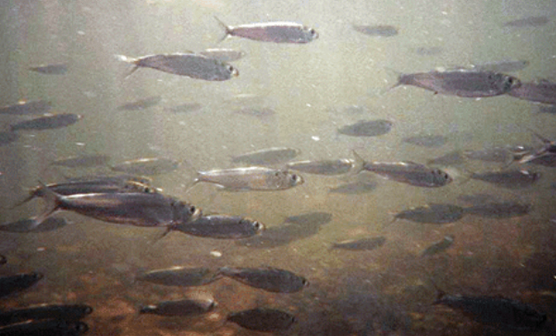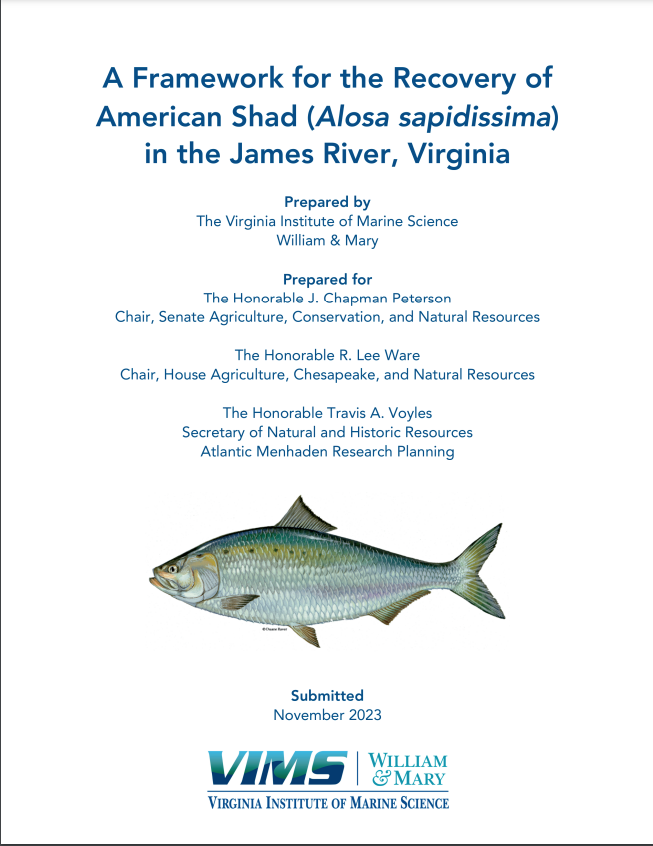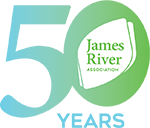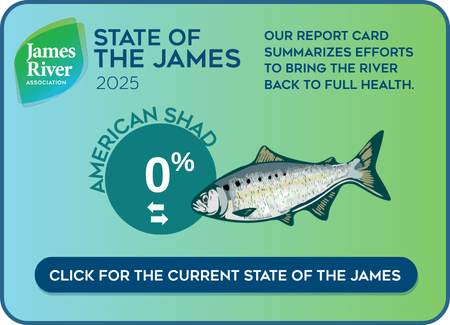Saving American Shad - The Founding Fish
American shad was once one of the largest commercial fisheries along the Atlantic coast.
Shad historically held significant economic and cultural value in Virginia, in addition to filling a critical ecological niche in its rivers and the Chesapeake Bay. The 2020 American shad stock assessment found that coastwide populations of American shad were depleted. It cited “multiple factors are likely responsible for shad decline such as overfishing, inadequate fish passage at dams, predation, pollution, water withdrawals, channelization of rivers, changing ocean conditions, and climate change.”
Shad have been particularly impacted by these factors in the James River watershed, where annually monitored shad abundance levels have reached all-time lows. Since 2021, the Virginia Institute of Marine Science’s (VIMS) monitoring data has American shad at 0% of the Chesapeake Bay Program’s shad abundance goal for the James River, underscoring the need for a recovery effort.
With the extensive cooperation of multiple Virginia stakeholders, including government agencies, academic institutions, Virginia tribes, and non-profits including JRA, a recovery plan aimed at the long-term restoration of the American shad population in the river was completed in 2023. With this framework for recovery as a guide, JRA will continue to strive for the recovery of this iconic species in the James.

Photo: U.S. Fish and Wildlife Service
Join our Action Network
The 2023 American shad stock assessment by the Virginia Institute of Marine Science found that populations of American shad in the James are at an all time low. Given the dire situation, JRA fought for funding to develop an emergency recovery plan that identified immediate actions that could be taken to improve the American shad fishery in the James River. Join JRA’s Action Network to help us advocate for an American shad recovery plan.
American Shad Recovery Plan
Delivered to the Virginia General Assembly in the Fall of 2023, A Framework for the Recovery of American Shad (Alosa sapidissima) in the James River, Virginia provides a consolidated look at the plight of the American Shad in the James, and lays out the next steps for recovery of the species. Or for quick reading, review the James River Association’s fact sheet for the recovery plan: Bringing Back American Shad.
Key Takeaways from the Recovery Plan
- The recovery plan identifies several principal factors likely responsible for the decline of American shad in the James, including limitations in habitat access, impacts from invasive species, and challenges with surface water intakes.
- This recovery plan provides recommendations to enhance American shad stocks in the James River; notably, a need for further study of American shad early life history and a suitability assessment of existing habitats before significant restoration efforts can begin.
- The proposed recommendations in the plan can benefit American shad stocks and other fish species in the James River, such as other river herring species, striped bass, sturgeon, and more.
- Climate change is identified as a contributing factor, affecting had and other species during the spawning season as well as in early life-stage development and beyond. Addressing this complex issue requires a strong and unified effort from partners and agencies.
Next Steps
- Fund American Shad Projects in the James:
- Existing Spawning Habitat Assessment (1)
- Evaluate Impacts of Climate Change on American shad (1)
- Continue & Expand American Shad Sampling Efforts (2)
- And many more necessary projects called for in the recovery plan
- Ensure DEQ requires assessments of the cumulative impacts of existing and proposed water intakes on the river ecosystem and fragile species like American shad.
- Establish FDA regulation for Blue Catfish Processing, as opposed to the current costly and cumbersome USDA oversight for the fledgling industry.
-
(1) Carried out by the Virginia Institute of Marine Science
(2) Caried out by the Department of Wildlife Resources

American Shad Fast Facts
- American shad is the largest species in the herring family and is native to the James River and Chesapeake Bay.
- Shad were an important food source for Native Americans, early colonists, and generations of Virginians. Shad roe is considered a delicacy by many Virginians and their Latin name Alosa sapidissima translates to “the most savory shad.”
- American shad are anadromous fish, meaning they migrate from saltwater to spawn in freshwater rivers like the James. Shad return to spawn in the same rivers where they were born and may migrate as much as 16,000 miles in their lifetime.
- Spring marks the arrival of American shad to spawn in the James River, typically when water temperatures reach 55F-65F, and when spring blooms start to appear. The shadbush (Amelanchier canadensis) gets its name American shad because it displays its white flowers close to the time shad spawn.
- Commercial landings of American shad in Virginia reached 11.5 million pounds in 1897. Harvest was less than a million pounds in 1982. In response to declines, Virginia placed a moratorium on the harvest of shad from Virginia’s rivers and the Bay in 1994.
Take Action Now
Join JRA’s Action Network or RiverReps program to help us advocate for an American shad recovery plan.
Additional Resources and References
- 2020 stock assessment for American Shad – Atlantic States Marine Fisheries Commission
- American Shad Restoration – Virginia Department of Wildlife Resources
- American Shad Monitoring – Virginia Institute of Marine Science
- Surface Water Withdrawal Intake Design and Operation Standards – Virginia Department of Wildlife Resources
- Underwater Grasses Interactive Map
- Water Withdrawal Permitting Requirements – Virginia Department of Environmental Quality
- EPA’s Cooling water intake rule
- The Blue Catfish Fishery – National Oceanic and Atmospheric Administration
- A case study of invasive blue catfish Ictalurus furcatus in Chesapeake Bay
- Aquatic barrier prioritization tool and interactive map
- Video – removal of Harvel Dam in Petersburg VA
- Gilligan-Lunda et al. 2021. Climate Change May Cause Shifts in Growth and Instantaneous Natural Mortality of American Shad Throughout Their Native Range. American Fisheries Society.


